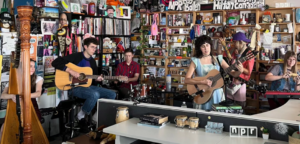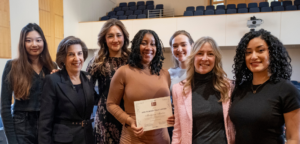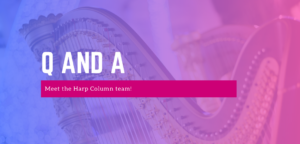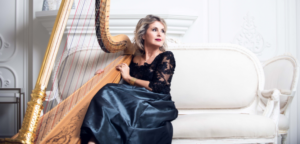Anyone who follows harp competitions will recognize the name Emily Mitchell from her first prize win at the 7th International Harp Contest in Israel. Since then, Mitchell has concertized throughout the world, as well as having an active career as a studio musician, Broadway player, and harpist with the Eos Orchestra in New York. Recently relocated to Texas, Mitchell now focuses on teaching and recording, especially the works of longtime colleague Gary Schocker. I caught up with Emily to find out more about her new recordings and what she’s up to these days…
Q: You just released two new recordings of music by Gary Schocker. Tell us why you’re drawn to Gary’s music.
As Gary and I have a 26-year performing/working relationship, performance and interpretation have made a compelling coupling. Gary’s music requires the ability to expand or contract while managing to stay within the confines of rhythm and style. His music at first glance looks simplistic, but it’s not! An advanced technique is required to play his bigger works, but it’s the ability to sound like you’re improvising as you are playing in order to interpret the beauty of the long line like a flute. As I wrote in the liner notes for Garden in Harp: A simple phrase can say a thousand words that a thousand notes cannot. This is my attraction to Gary’s music. I have always identified with his music; his beautiful, elegant melodies and corresponding harmonies free of excess. It’s my legacy to share his music with the harp world.
Actually, Garden in Harp is a reissue from its original release on Azica Records in 2012. As my contract with Azica had expired, I wanted to have all four of my Gary Schocker recordings under the same label, Albany Records. Garden has a new cover, artwork by Olya Meek, and new liner notes. Changes is the newest release earlier this year. The other two recordings are A Harp for Christmas, Vols. 1 & 2, of Gary’s published Christmas carol arrangements “Joy to the World!” and “In the Moon of Wintertime.”
Q: Tell us about the recordings. What’s on them, and how did you pick the music?
Garden is a harp chamber music CD, works written between 1993 and 2010. There are three works for flute and harp, a trio for flute, viola, harp and one for flute, oboe, harp. There’s a gorgeous confection for trombone and harp and a bookend piece, “Cherry Blossoms,” that can be added to any program with quartet, flute, and clarinet. The only harp solo on the CD is “Garden in Harp,” a four-movement piece published by Lyon & Healy. Changes is a mix of solo and ensemble. A flute and harp piece, two duo harp pieces: “Better Than One” and “Snow,” and three solos including the solo harp version of “In Memoriam” originally written for piano, adapted for flute and harp and further adapted for harp solo two weeks before recording. This repertoire was written between 2012 and 2016.
When it comes to recording, it is very difficult to choose what to record from so much Schocker repertoire. I have my favorites, but I program music that works together to tell a story. Changes got its name from the harp solo “Aria and Changes” that happened to coincide with the changes occurring in my life. The original CD title was going to be In Open Air, a trio for flute, cello, harp, but the CD was too long so we shelved the trio recording to put on another CD. I was struggling with a heavy heart as my former husband died unexpectedly the month before recording. Then in the middle of editing the CD, my producer, who produced my RCA albums and all others with the exception of Garden, died unexpectedly. It took a great deal of strength to finish editing Changes without him; the release date kept getting pushed forward for a CD that was supposed to be released in 2015.
Q: On “Changes” you teamed up with Jaymee Haefner. How did the two of you start working together?
The marvelous Jaymee Heafner and I knew each other from being on the Board of the American Harp Society. She was the Chair for the 2011 AHS Institute at North Texas State University in Denton, Texas, the year before I was Chair for the 2012 50th Anniversary AHS Conference in N.Y.C. I had moved to Texas from New York in 2008 and was looking for a duo harp partner. It was at the 2011 Institute that Jaymee and I discussed forming a harp duo to play Gary’s new duo harp music. We have a mini-tour this October scheduled in San Antonio (Concerts at St. John’s), Fayetteville, Cypress ,and Frisco (Astraios Chamber Music). We have other dates pending.
Q: You’ve performed and taught throughout the world, and lived for a long time in New York. What brought you to your current location in Texas?
I left New York to care for my mother. Her needs have now exceeded the abilities of home care and she is in a living assisted home. This allowed me to change my direction in life once again. I didn’t want to move back to NY, though. After being away for eight years, my priorities had changed. What I did want to do was pursue my teaching at Stephen F. Austin State University in Nacogdoches to bring a harp presence to East Texas. It seemed like a gift to find an untapped area for development. I moved to Nacogdoches last June. I’d been commuting from Houston to teach while I was caring for my mother. Now I can develop a harp studio actually living where I teach. SFA also has a Music Prep division for elementary, secondary, and adult students as well as college. I’m also teaching at Sam Houston State University in Huntsville, Texas, about an hour north of Houston. I accepted this position a few months before I knew I was moving to Nacogdoches. Now I have the same problem in reverse of commuting back to the Houston area from Nac! But, Nac to Huntsville is not nearly as far as Nac to Houston. If all goes well in Nac, it should spill over to Huntsville. Incidentally, Sam Houston State is on a small list of universities that offer undergraduate and graduate degrees in Music Therapy.
You’ve been a studio musician with some of the biggest names in music. Who has been your favorite artist to work with, and do you have any interesting or funny stories to tell?
Studio work came later in life. I’d spent a great deal of my time touring for Columbia Artist’s Community Concerts. I didn’t start recording session work until the early 1990s, a few years after my children were born and touring was no longer an option. There have been funny and serious moments that stick out in my memory. I loved working with Barbra Streisand on her first tour as part of the East Coast Orchestra, with Marvin Hamlisch conducting. Just to be a part of that Hollywood scene was extraordinary. Sting was fun. I was playing with his band and the Gil Evans’ band at the Perugia Jazz Festival when I was pregnant with my second daughter (summer of 1987). Rehearsals were in NYC. One afternoon I was craving a cheeseburger. My husband got me a greasy one while we were on break. I was just about to sink my teeth into this little piece of heaven when Sting grabbed the burger out of my hands and chastised my husband saying, “She can’t eat this. She’s pregnant!” Sting, to this day, has no idea how close he came to losing his arm! Moot point now that I don’t eat very much beef.
Michael Jackson came in to my isolated room on a recording session. He shook my hand. I recall him being very thin. His grip was cold and clammy. But he was kind and gentle and he wanted to buy my harp. I declined. I told him to go to Lyon & Healy to order a beautiful gold harp. Don’t know if he ever did. Bette Midler was wonderful to work with. I was part of her band on the Today show and the Martha Stewart show. As she was walking past me to perform, she turned to me on camera and said, “Emily, what’s my note”? Fortunately, I knew her starting note and gave her a resounding E flat. James Galway is a good friend. We recorded together for RCA and performed live on the Today show and Good Morning America. We performed in Carnegie Hall (Mozart flute and harp concerto with St. Luke’s Orchestra). Shortly before I left NY I started playing Broadway. I subbed for various shows and then was offered the regular harpist position for Thoroughly Modern Millie. Those were two of the best years of my life. The pit orchestra was like family. Just before the show opened, RCA recorded the cast album. At a meeting with RCA staff and the show’s conductor and contractor, someone from the RCA staff noticed I was hired to play harp. She said, “You got Emily Mitchell?, theee Emily Mitchell?” For two years the orchestra ribbed me for being theee Emily Mitchell. A little annoying, but nice to be appreciated.
Any least favorite experiences to share???
The only people who come under the heading of “least favorite” would be some composers and conductors. I won’t name names, but those of us who subbed for fabulous harpist Anna Reinersman for The Producers have a lot of stories to tell. I found my comfort zone in studio work. It could be stressful too, but most of the time harp parts are easy to sight-read. Sometimes harp parts are not well written and you are glad you have the experience to sight-read a poorly written part and make it sound good. A very high profile film directed by Robert De Niro, who was in the recording booth during recording, was supposed to have a music score written by film composer James Horner (Titanic, Avatar, The Magnificent Seven), who loves to write for harp. At the last minute he was replaced by a young composer from Brazil. At one point, this guy stopped recording to complain on an open mic that my harp did not sound like the harp on his computer. The entire room was stunned. The conductor looked at me with his mouth open. The contractor was trying to keep the composer happy and looked at me to do something! It came to me to play everything pdlt to dry out the sound and make it sound shallow. Years of cultivating my sound down the tubes… There were other incidents of young composers who had learned to compose from the computer.
On another film score, a young composer announced to the orchestra that he didn’t know much about music. Proud of it he was and turned to the bass players and said, “What’s it called when you go thump, thump, thump”? The principal bassist wryly said, “Pizzicato”? The concert master of the NY Philharmonic who was leader on that session just put his head in his hands. New York, at the time, was known to have a top film score recording business. I lived to see the NY recording industry shanghai’d by some interesting adjustments as technology proceeded to change the horizons of live music forever.
Q: What’s your favorite piece to play on the harp and why?
I honestly can’t say I have a favorite piece. It’s like choosing a favorite color. Can’t choose just one? I love music from the 18th century, early classics, of course the Impressionists. I like contemporary and some avant-guard.
Q: Least favorite?
I’m not fond of music that’s written like a mathematical equation. I have the luxury now that I’m older not to play music I don’t like. I’m not fond of the Krenek Sonata. All those minor 7th chords and polytonality set my teeth on edge. Second movement is nice.
What’s next on your harp to-do list?
Jaymee and I want to record a complete duo harp CD including Gary Schocker’s new duo works “Heavens Above” and “Coasting.” “Heavens Above” was performed at the 2016 AHS Atlanta Conference by our students Susanna Campbell and Danielle Harmon. I thought Changes would be my last Schocker CD, but he keeps writing all this great music… Maybe there are other recordings in me. Gary wrote an exquisite lever harp piece, “Imaginary Folksongs,” for me to play at the Southeastern Harp Weekend. It’s a condensed version of the pedal harp piece. It would be nice to record both pieces on the same CD.
Q: When you’re not playing the harp, what’s your favorite thing to do?
I’m a bit reclusive. I love puttering around home. This gives me plenty of time for practice and just playing the harp. I really don’t have many outside interests although I love museums and films: art films, documentaries as well as the latest Hollywood blockbuster. I also love going to concerts, especially harp concerts. I’m not an opera buff, except for Mozart and Wagner. I enjoy writing and would like to turn my creativity toward that activity as well as getting back to knitting and crocheting. Keeping my harp playing “chops” up keeps me busy enough for now.
Q: Anything else you want Harp Column readers to know about you?
If you’re interested in the nurturing of a small school for collegiate work, consider Stephen F. Austin State University in Nacogdoches or Sam Houston State University in Huntsville. The advantage of a smaller school is that I am able to teach all of my students. That not only includes their private harp lessons, but chamber music, pedagogy and harp class.
There is a vicious circle for collegiate music majors between academic study and practice time. Often music students are not left with a lot of time to practice. Don’t overload your schedule so much that you can’t give quality time to your major. Go to summer school to work off academics. Students who don’t practice consistently are frustrating at best. They forget the teacher has to grade how well they come prepared for each lesson not just the end result of cramming to prepare for juries and recitals.
Four years is really a very short time. Harp students who come to school with the singular ambition to work hard even over holidays will advance quickly and be able to hold their own. At the end of four years, they have a degree that means something more than a piece of paper. They are ready to go into the world and find their place.














